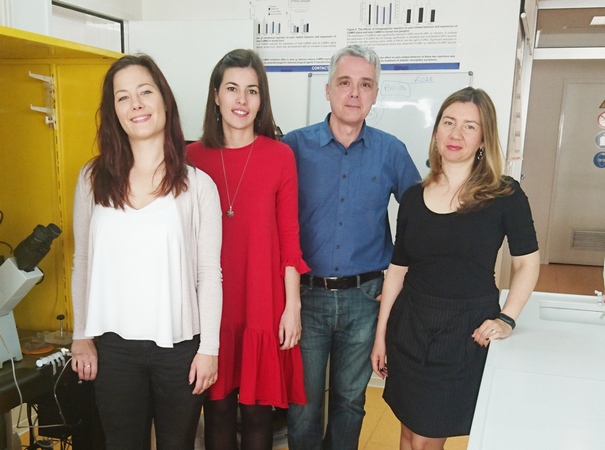
Head of research group

Professor Damir Sapunar MD, PhD
Research
Evidence-based medicine research
Projects
Treating neuropathic pain with dorsal root ganglion stimulation - NeuroMod
*for complete project list, please, follow the link
Team members/Collaborations
Prof Damir Sapunar, MD, Ph. D. head of research group [CV]
Assoc. Prof Livia Puljak, MD - lead researcher [CV]
Tihana Repić, M.Sc. mol. biol. - doktorand [CV]
Ivana Vuka, M.Sc. biol. et oecol. mar. - doctoral student [CV]
Svjetlana Došenović, MD - doctoral student [CV]
Krste Borić, MD - doctoral student [CV]
Filipa Markotić, MD - doctoral student [CV]
Tonći Brković, MD - doctoral student [CV]
Andrija Babić, MD - doctoral student
Katarina Vučić, MD - associate [CV]
Antonia Jeličić Kadić, Ph. D. - associate
Matija Borić, Ph. D. - associate
Marina Biočić, MD - associate [CV]
Prof Quinn Hogan, Medical College of Wisconsin - associate
Assoc. Prof Violeta Ristoiu, University of Bucharest - associate
Assoc. Prof Elsa Fabretti, University of Nova Gorica - associate
Foto gallery
Future directions
Selected publications

Professor Damir Sapunar MD, PhD
Research
Nerve injury is a dominant contributing factor in etiology of neuropathic pain, which is a common, often intense and usually poorly treated condition. Although dorsal root ganglion (DRG) neurons are a proven site of initial pathophysiological changes in neuropathic pain, we do not know how pain sustains itself long after the original injury has healed. Our main interest centers on primary afferent neurons of the DRG that transmit nociceptive information. These neurons are a heterogeneous population with diverse sensory modalities, anatomic targets, receptors, expression of peptides and, critically, a diverse reaction to injury. Among the most important post-injury changes is electrical hyperexcitability and abnormal impulse generation (ectopic electrogenesis) that develops in injured primary sensory neurons. We are interested in a subgroup of DRG neurons that may contribute to neuropathic pain through a major shift in their functional properties after peripheral nerve injury. Our results (Anesthesiology 2005;103:360) show that axotomy provokes a generation of a novel phenotype of sensory neurons with electrophysiological features that resemble both low-threshold and nociceptive specific neurons. Our overall goal is to modulate neuronal activity of these cells using different procedures and potential drugs. In order to address these issues we are using several aminal neuropathic pain models, in vivo DRG targeted drug delivery (J Neurosci Methods. 2009;177(2):397), histological techniques, behavioral tests and in vitro electrophysiology recordings with subsequent immunofluorescence characterization of the recorded DRG cells. Identification of a pathogenic mechanism in an injury-induced subgroup of sensory neurons has a strong potential to develop selective pain therapies with fewer side effects.
Evidence-based medicine research
Within Cochrane Croatia our Laboratory is conducting a number of studies devoted to promotion of evidence-based medicine and assessment of published evidence. Particular focus of our epidemiological and meta-epidemiological studies is on evidence in the field of pain. We conduct high-quality systematic reviews and meta-epidemiological studies whereas we appraise quality and quantity of evidence about efficacy and safety of interventions in the field of pain.
Projects
Treating neuropathic pain with dorsal root ganglion stimulation - NeuroMod
Lead researcher: Prof Damir Sapunar
Funded by Croatian Science Foundation - HrZZ
Funded by Croatian Science Foundation - HrZZ
Duration: dec 2014 - dec 2017
The effect of electrical stimulation of peripheral nerve on pain related behavior in rats
Lead researcher: prof. dr. sc. Damir Sapunar
Bilateral Croatian - Slovenian project
Bilateral Croatian - Slovenian project
Duration: mar 2016 - mar 2018
*for complete project list, please, follow the link
Team members/Collaborations
Prof Damir Sapunar, MD, Ph. D. head of research group [CV]
Assoc. Prof Livia Puljak, MD - lead researcher [CV]
Tihana Repić, M.Sc. mol. biol. - doktorand [CV]
Ivana Vuka, M.Sc. biol. et oecol. mar. - doctoral student [CV]
Svjetlana Došenović, MD - doctoral student [CV]
Krste Borić, MD - doctoral student [CV]
Filipa Markotić, MD - doctoral student [CV]
Tonći Brković, MD - doctoral student [CV]
Andrija Babić, MD - doctoral student
Katarina Vučić, MD - associate [CV]
Antonia Jeličić Kadić, Ph. D. - associate
Matija Borić, Ph. D. - associate
Marina Biočić, MD - associate [CV]
Prof Quinn Hogan, Medical College of Wisconsin - associate
Assoc. Prof Violeta Ristoiu, University of Bucharest - associate
Assoc. Prof Elsa Fabretti, University of Nova Gorica - associate
Foto gallery
Future directions
Functional analysis of injured primary afferent neurons. Nerve injury is a dominant contributing factor in etiology of neuropathic pain, which is a common, often intense and usually poorly treated condition. Although dorsal root ganglion (DRG) neurons are a proven site of initial pathophysiological changes in neuropathic pain, we do not know how pain sustains itself long after the original injury has healed. Our main interest centers on primary afferent neurons of the DRG that transmit nociceptive information. These neurons are a heterogeneous population with diverse sensory modalities, anatomic targets, receptors, expression of peptides and, critically, a diverse reaction to injury. Among the most important post-injury changes is electrical hyperexcitability and abnormal impulse generation (ectopic electrogenesis) that develops in injured primary sensory neurons. We are interested in a subgroup of DRG neurons that may contribute to neuropathic pain through a major shift in their functional properties after peripheral nerve injury. Our results (Anesthesiology 2005;103:360) show that axotomy provokes a generation of a novel phenotype of sensory neurons with electrophysiological features that resemble both low-threshold and nociceptive specific neurons. Our overall goal is to modulate neuronal activity of these cells using different procedures and potential drugs. In order to address these issues we are using several aminal neuropathic pain models, in vivo DRG targeted drug delivery (J Neurosci Methods. 2009;177(2):397), histological techniques, behavioral tests and in vitro electrophysiology recordings with subsequent immunofluorescence characterization of the recorded DRG cells. Identification of a pathogenic mechanism in an injury-induced subgroup of sensory neurons has a strong potential to develop selective pain therapies with fewer side effects.
Selected publications
Interests and topics: Pain, neuropathic pain, dorsal root ganglion, evidence-based medicine, epidemiology, meta-epidemiology
Print page









